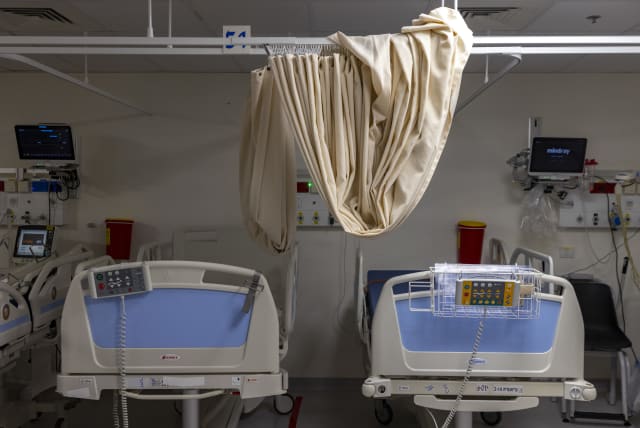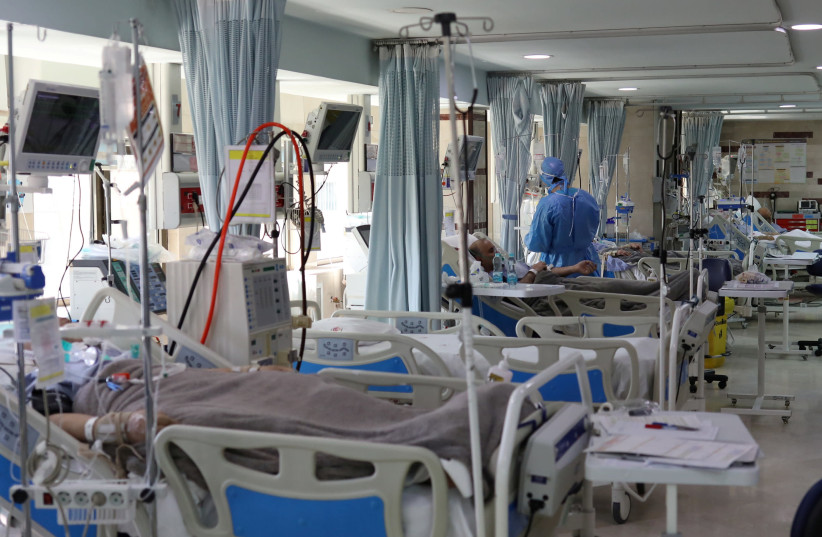Israel's hospital bed shortage continues, wait times longer than ever

The rate of beds for acute care in Israel is only 2.0 per 1,000 people, a figure significantly lower than the OECD average, which is 3.5.
The rate of hospital beds in general, psychiatric, rehabilitation and geriatric hospitals in Israel lags way behind the average in the advanced OECD countries, the Health Ministry said Thursday.
In a report titled “Licensed Hospital Beds and Positions, December 2022”, compiled by Ziona Haklai, head of the ministry’s Health Information Division, the data show how the rate of beds for acute care in Israel is only 2.0 per 1,000 people, a figure significantly lower than the OECD average, which is 3.5. Most hospitals here still have patients lying in the corridors due to the lack of wards, equipment and enough doctors and nurses. This only worsens in the winter.
The rate of beds for acute psychiatric treatment is 0.3 per 1,000 people (OECD average is 0.4), while the rate of beds for rehabilitation treatment is 0.3 (OECD average is 0.5).
Additionally, the rate of long-term care beds is 2.9 per 1,000 people aged 65 and over (OECD average is 3.6), and the rate of beds in nursing institutions for chronic conditions including dementia stands at 16.9 per 1,000 people aged 65 and over (OECD average is 41.0).
In 2022, only 461 beds were added for general hospitalization around the country, leaving the number of hospitalization beds in Israel still low by every comparative parameter.
From the end of 2010 to the end of 2022, only 2,146 beds were added. The highest number of beds added since 2010 was in the southern and northern districts.
Ministry Director-General Moshe Bar Siman Tov, an economist and who previously served as director-general under then-minister Ya’acov Litzman, wrote that “In the upcoming budget, the Health Ministry will work to make a leap forward in the plan to increase the number of hospital beds and home hospitalizations to respond to the aging of the population and its growth.
“In the last decade, many hospital beds were added, with the most in the northern and southern districts, in a prioritization of the periphery,” largely due to the building and opening of the Samson Assuta Ashdod University Hospital.
The director-general added that additional hospitals will be promoted in the future.
“In the long term,” he added, “there is a national outline plan, which includes setting aside locations for hospitals until the year 2048 [Israel’s centenary] and will double the number of Israeli hospital beds.”
Problems in healthcare
Channel 12 reported on Wednesday night that the queues for seeing a medical specialist in virtually all fields at public health fund clinics is extremely long – four to six months for oncologists.
This is due to the four health funds’ NIS 4 billion deficit. This problem was intensified when Benjamin Netanyahu was finance minister between 2003-2005 and canceled the Parallel Tax that employers paid to help cover health costs. It was never restored, causing a severe deficit and forcing Health Ministry officials to go hat in hand to Treasury budget division officials asking for more money, but the gap has never been closed.
Last year, of the 461 beds added for standard general hospitalization, 54 were in oncology departments; 50 in neurology, 49 in internal medicine, 49 in general surgery, 48 in cardiac intensive care, 38 in general intensive care, 30 for children, 22 in pediatric intensive care, 22 for obstetrics/gynecology and the rest in the other departments.
At the end of 2022, there were 16,869 beds for general hospitalization, of which 16,739 are in hospitals for general hospitals and 130 in geriatric hospitals.
The rate of beds was 1.746 per 1,000 people, an increase of just 1% from the previous year – a decrease of 5% from 1.830 in 2015 and a decrease of 9% from the end of 2010, when it was 1.913.
The number of beds for general hospitalization by the district was:
Jerusalem: 2,425 beds, with the addition of 344 beds between 2010-2022; the North with 2,275 beds, with the addition of 405 between 2010-2022; Haifa with 2,564 beds, with the addition of 171 beds between 2010-2022; the center with 3,958 beds, with the addition of 306 beds between 2010-2022; Tel Aviv has 3,568 beds, with an addition of 375 beds between 2010-2022; and the South, with 2,079 beds and an addition of 545 beds between 2010-2022.
In 2022, there were 3,570 beds for psychiatric patients, of which 3,482 were in public hospitals. From the end of 2010, 119 standard beds were added. The rate of beds decreased to 0.370 per 1,000 people, a decrease of 2% from the previous year, 11% from 2015 and 18% from 2010, when it was 0.448.
At the end of 2022, there were 26,425 geriatric beds, of which 21,488 (81%) were for prolonged geriatrics and 4,937 (19%) were for active geriatrics. From the end of 2010, 2,738 beds were added, of which 1,119 beds were for long-term geriatrics and 1,619 were for active geriatrics, an increase of 5% from 2010 and 49%, respectively, and one percent and 19% from 2020, respectively.
At the end of 2022 there were 957 beds for all types of rehabilitation. From the end of 2010, 193 standard beds were added. The rate of beds was 0.099 per 1,000 people, an increase of just 1% from 2020.
Jerusalem Post Store
`; document.getElementById("linkPremium").innerHTML = cont; var divWithLink = document.getElementById("premium-link"); if (divWithLink !== null && divWithLink !== 'undefined') { divWithLink.style.border = "solid 1px #cb0f3e"; divWithLink.style.textAlign = "center"; divWithLink.style.marginBottom = "15px"; divWithLink.style.marginTop = "15px"; divWithLink.style.width = "100%"; divWithLink.style.backgroundColor = "#122952"; divWithLink.style.color = "#ffffff"; divWithLink.style.lineHeight = "1.5"; } } (function (v, i) { });

